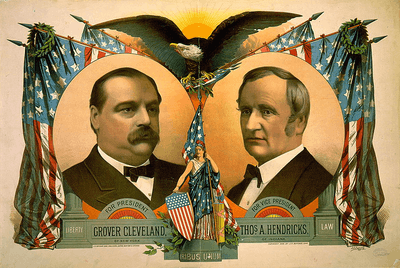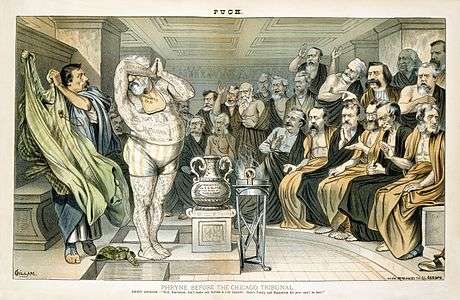Grover Cleveland 1884 presidential campaign
The 1884 election was the first Presidential campaign in which Grover Cleveland participated and the first of two nonconsecutive terms that he won. This election pitted Grover Cleveland against James G. Blaine and the campaign for this election centered on corruption, civil service reforms, and scandals. In this election, Cleveland portrayed himself as the clean and honest candidate in contrast to the corrupt James G. Blaine.
| Grover Cleveland for President | |
|---|---|
 | |
| Campaign | U.S. presidential election, 1884 |
| Candidate | Grover Cleveland Sheriff of Erie County (1871-1873), Mayor of Buffalo (1882), Governor of New York (1883-1885) Thomas A. Hendricks U.S. House of Representative from Indiana (1851-1855), U.S. Senator from Indiana (1863-1869), Governor of Indiana (1873-1877) |
| Affiliation | Democratic Party |
| Status | Won general election |
The nomination fight

In the years leading up to 1884, the Republican Party was divided into two factions—the Stalwarts and the Reformers.[1][2] In 1884, Reformer James G. Blaine was able to defeat incumbent Stalwart U.S. President Chester A. Arthur's attempt at renomination.[1][2] In Arthur's place, Blaine himself was nominated as the Republican Party candidate for President in 1884.[1][2] Meanwhile, U.S. Senator and former general John A. Logan was selected as Blaine's running mate after Robert Todd Lincoln withdrew his name from consideration.[2]
1876 Democratic candidate and former New York Governor Samuel J. Tilden was initially the 1884 front-runner for the Democrats.[2] Due to his poor health, however, Tilden withdrew his name from consideration for the 1884 Democratic nomination.[2] After Tilden's withdrawal, then-current New York Governor and former Buffalo Mayor Grover Cleveland (known as "Grover the Good"[3]) emerged as the front-runner for the Democrats.[2] As Governor, Cleveland was notable for implementing civil service reform in New York as well as for preserving Niagara Falls as a state park.[2] In addition, Cleveland's position on the tariff issue was unclear—thus allowing him to appeal to both high tariff supporters and low tariff supporters.[2] Plus, the fact that he was from a swing state (New York) further strengthened Cleveland's appeal among Democrats.[2] Finally, Cleveland won a lot of support for cutting off the patronage of the corrupt New York City political machine known as Tammany Hall while he was New York Governor.[2]
On the first ballot at the 1884 Democratic National Convention, Cleveland won 392 delegates to 170 delegates for his closest rival, Delaware U.S. Senator Thomas F. Bayard.[2] Afterwards, Cleveland's campaign managers worked behind the scenes to prevent opponents of Cleveland's from consolidating around any single candidate.[2] This strategy was successful as Cleveland won the nomination with 683 delegates at the second ballot.[2] For Vice President, Indiana U.S. Senator Thomas A. Hendricks (previously the 1876 Democratic Vice Presidential nominee) was chosen (as Cleveland's running mate).[2] During the campaign, Hendricks would serve as an attack dog for Cleveland and constantly hammer the Republican ticket and Republican Party for their record, agenda, and character.[4]
Campaign
Running on a platform of honesty and reform, Cleveland was helped by the fact that many reformist Republicans—known as Mugwumps—were uncomfortable with their candidate (James G. Blaine).[4] Specifically, the Mugwumps disliked Blaine's corruption, his imperialist foreign policy as President Garfield's Secretary of State, and his opposition to civil service reform and other reforms.[4]

While a revelation by the Buffalo Evening Telegraph on July 21, 1884 about Cleveland allegedly fathering a child out of wedlock (by Maria Halpin) threatened to hurt Cleveland's campaign, Cleveland was able to take control and handle this issue by telling the truth.[4] Specifically, Cleveland pointed out that, while he didn't think that this child was his, he nevertheless took responsibility for this child due to him being the only bachelor among his friends.[4][5] Also, Cleveland pointed out that he put the child up for adoption (with this child later being adopted by a wealthy couple) once Mrs. Halpin's alcoholism threatened this child's welfare.[4] This clarification, Cleveland's apparent honesty, and the fact that Cleveland stood his ground allowed him to successfully recover from this scandal.[4] Maria Halpin herself (in an 1884 interview) and Charles Lachman (in a 2011 article) questioned the veracity of Cleveland's side of this story.[5][3][6]
In spite of Blaine's conversion in support of civil service reform, the Mugwumps were unconvinced and continued to support Cleveland.[7] Meanwhile, two events hurt Blaine's campaign in its final days.[7][8] Firstly, Catholic Irish-Americans voters were alienated from Blaine when Blaine supporter and clergyman Samuel Burchard portrayed the Democrats as the party of "Rum, Romanism, and Rebellion."[7][9][8] Secondly, Blaine attended a dinner at a New York restaurant called Delmonico's which was filled with wealthy people (such as Jay Gould and John Jacob Astor); in turn, this caused Blaine to be portrayed as a supporter of the wealthy and as uncaring about the plight and needs of the working class.[7][8]
Results
Due to the very close vote in New York, it was several days before the results of this election became known.[7] Ultimately, Cleveland won New York state by 0.10% (1,149 votes)--and with it the decisive votes in the Electoral College—while winning the national popular vote by less than 0.30%.[7][10][8] Specifically, Cleveland was helped in New York state by the support of the reformist-minded Mugwumps[11] as well as by the fact that Prohibitionist nominee John St. John took some votes in New York from Blaine.[7] After the election, Blaine attributed his loss in New York to the bad weather as well as to Samuel Burchard's gaffe; without these factors, Blaine believed that he would have won New York by 10,000 votes (and thus won the U.S. Presidency).[12]
Overall, 1884 was the first time in 28 years—specifically since before the American Civil War—that the Democrats won an election for the U.S. Presidency.[13]
References
- "HarpWeek | Elections | 1884 Overview". Elections.harpweek.com. Retrieved 2017-09-17.
- "HarpWeek | Elections | 1884 Overview". Elections.harpweek.com. Retrieved 2017-09-17.
- 05.23.11 7:38 PM ET. "Grover Cleveland's Sex Scandal: The Most Despicable in American Political History". Thedailybeast.com. Retrieved 2017-09-19.
- "HarpWeek | Elections | 1884 Overview". Elections.harpweek.com. Retrieved 2017-09-17.
- "President Cleveland's Problem Child | History | Smithsonian". Smithsonianmag.com. 2013-09-26. Retrieved 2017-09-18.
- Levine, Bruce E. "3 of the biggest misogynists to reach the oval office before Donald Trump got there". Salon.com. Retrieved 2017-09-19.
- "HarpWeek | Elections | 1884 Overview". Elections.harpweek.com. Retrieved 2017-09-17.
- "The Dirtiest Election". American Heritage. Retrieved 2017-09-19.
- "Moment of Truth: Scandal in the Election of 1884". HistoryNet. Retrieved 2017-09-19.
- Leip, David. "Dave Leip's Atlas of U.S. Presidential Elections". Uselectionatlas.org. Retrieved 2017-09-17.
- "Grover Cleveland". whitehouse.gov. Retrieved 2017-09-19.
- Scher, Bill (2015-10-29). "Gaffe at GOP dinner upends presidential election: Oct. 29, 1884". Politico. Retrieved 2017-09-19.
- "Previous Trivia Of The Week". President Elect. Archived from the original on 2017-08-11. Retrieved 2017-09-17.